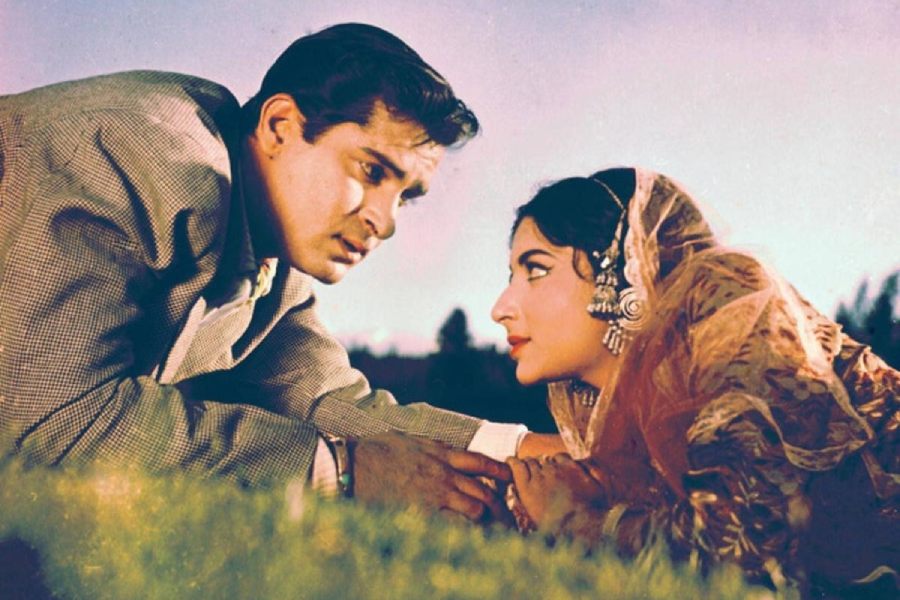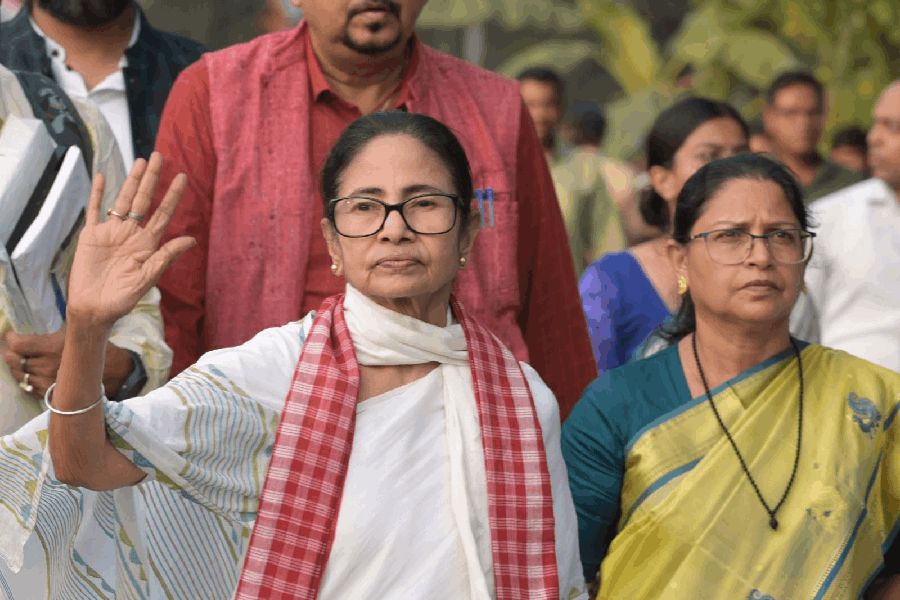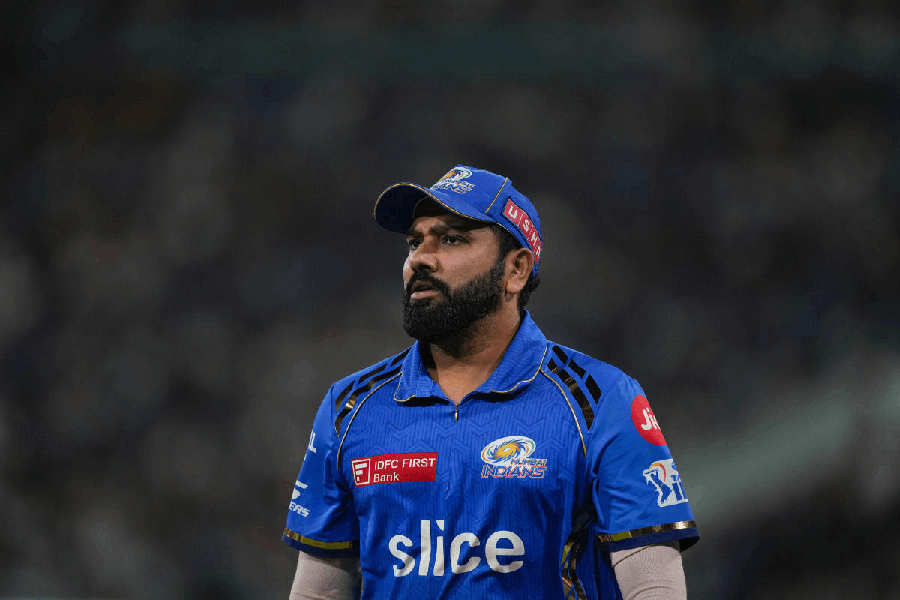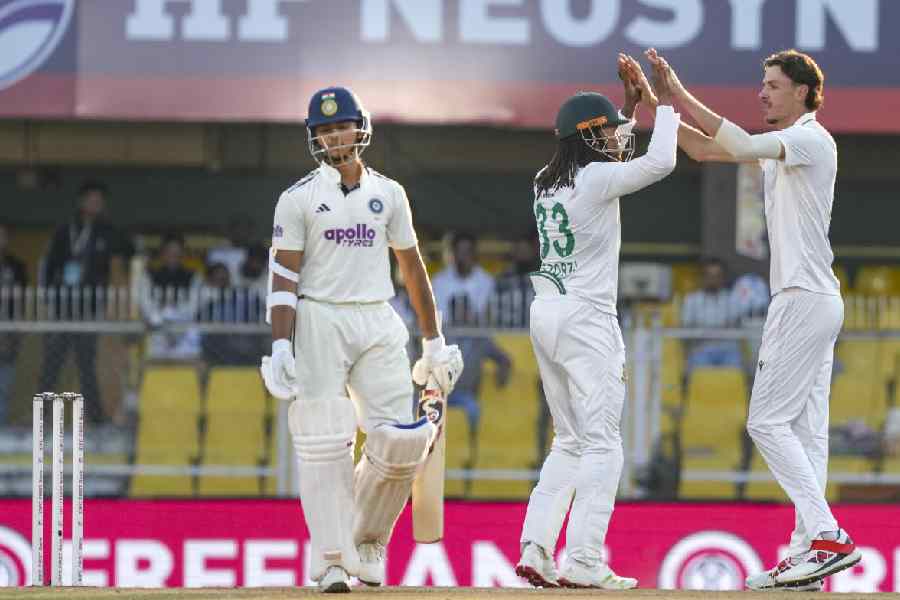In the vast archive of Hindi cinema’s musical history, certain images become indelibly etched into our collective memory – an actress draped in chiffon, her expressive eyes framed by kohl, her silhouette moving in sync with immortal melodies. One such image is that of Sharmila Tagore, whose legacy is often framed around her luminous performances, her graceful crossover from Bengali art cinema to Hindi blockbusters, and her enduring collaborations with stalwarts like Rajesh Khanna, Satyajit Ray and Shakti Samanta. Yet, an essential component of her stardom – her deep association with the golden era of Hindi film music – has been relatively underexplored.
What also makes this exploration necessary is that in almost all instances, musical success in Hindi cinema is attributed largely to its male stars. So it is that we have a Dev Anand, a Shammi Kapoor, a Rajesh Khanna, a Rishi Kapoor or an Amitabh Bachchan being feted for musical blockbusters, while a Waheeda Rehman or a Mumtaz or a Neetu Singh and Jaya Bachchan, as much a part of the success, are never mentioned in the same breath. Imagine Guide without Waheeda Rehman or the songs of Tere Ghar Ke Samne without Nutan. What would Do Raaste be without ‘Bindiya chamkegi’ or Khel Khel Mein without Neetu Singh? Is it possible to envisage Abhimaan without Jaya Bachchan?
It is in this light that one needs to study the soundscape that accompanied Sharmila Tagore’s rise and consolidation as a major star. For close to 15 years from 1964, few leading ladies could claim such an enviable line-up of musical blockbusters, where songs not only punctuated the narrative but often became central to the film’s identity.
Kashmir Ki Kali: The musical debut in Hindi cinema
Though Sharmila Tagore had already debuted under Satyajit Ray’s direction in Apur Sansar (1959), and created an enviable body of arthouse Bengali films over the next four years, it was Kashmir Ki Kali (1964) that launched her into the realm of Hindi commercial cinema. Directed by Shakti Samanta, the film is drenched in colour, location and music – three trademarks of the 1960s romantic Hindi film.
It is impossible to discuss the film without invoking its musical legacy, though being cast opposite Shammi Kapoor meant that the credit for the film’s music went to its hero. Composed by OP Nayyar, the soundtrack is bursting with hits: ‘Deewana hua badal’, ‘Yeh chand sa roshan chehra’, and ‘Isharon isharon mein’. It bears mentioning that each of these songs, visually stylised and lyrically loaded with flirtation and romanticism, feature Sharmila as an integral part, turning her into the quintessential dream girl of Kashmir. Her playful expressions, paired with Nayyar’s lively rhythms and Asha Bhosle’s spirited playback, gave Hindi cinema a fresh, modern heroine who was at once traditional and alluringly new.
The evergreen grace of Waqt
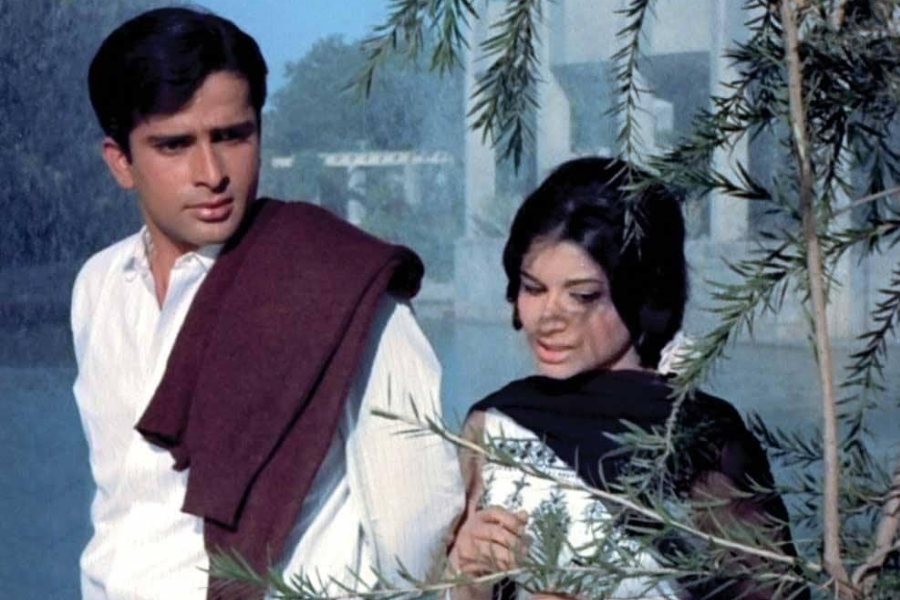
A still from 'Waqt' IMDb
Waqt, a multi-starrer helmed by Yash Chopra, is often discussed for its lavish scale, family drama, and ensemble cast. Despite the high-intensity drama involving Sunil Dutt and Raaj Kumar, and the romantic pairing of Sunil Dutt and Sadhana, what appealed to the young audience at the time was the musical interplay between Sharmila Tagore and Shashi Kapoor that gave the film its emotional core, nowhere more palpable than in the evergreen hit ‘Din hai bahar ke’. Picturised on Shashi Kapoor and Sharmila Tagore picnicking with college friends on a boat, the song aptly articulated the characters’ attitudes to life. The song became a sort of youth anthem, with demand surging to copy Sharmila’s costume designed by Bhanu Athaiya while salons were crowded by girls requesting to replicate her haido.
The europhile’s muse: An Evening in Paris
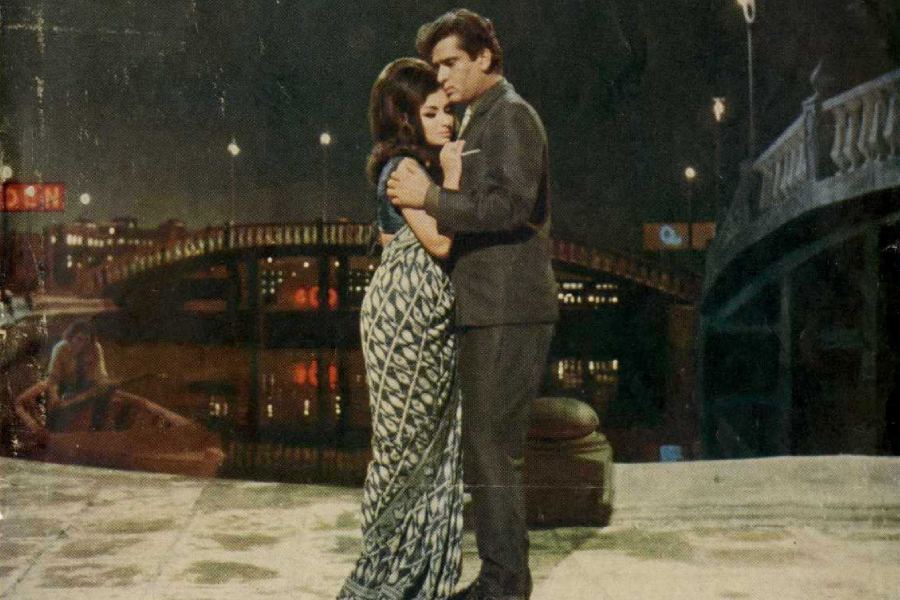
A still from 'An Evening in Paris' IMDb
By 1967, Sharmila had become synonymous with the cosmopolitan heroine. In An Evening in Paris, she took it a notch higher, portraying a double role in a film that revelled in exotic locations, cabaret numbers and high fashion. Shankar-Jaikishan’s music gave the film its pulse. Tracks like ‘Raat ke humsafar’ and the iconic ‘Aasman se aaya farishta’ found Sharmila portraying glamour with confidence. Her emoting to ‘Le ja le ja mera dil’ is a lesson for actors in coquetry and seduction as she exudes enough oomph to fire up the most jaded male fantasy. Or for that matter, ‘Zooby zooby jalembu’ where she pulls off that outrageous headgear and the skimpy outfit with élan, while gyrating to the song’s infectious melody without missing a beat. For an actress who had begun with quiet, introspective roles in Apur Sansar and Devi, the transformation into a bikini-clad siren singing in dance clubs was radical, and musical cues played a major role in constructing this shift.
Introspective melodies: Anupama, Talash and Safar
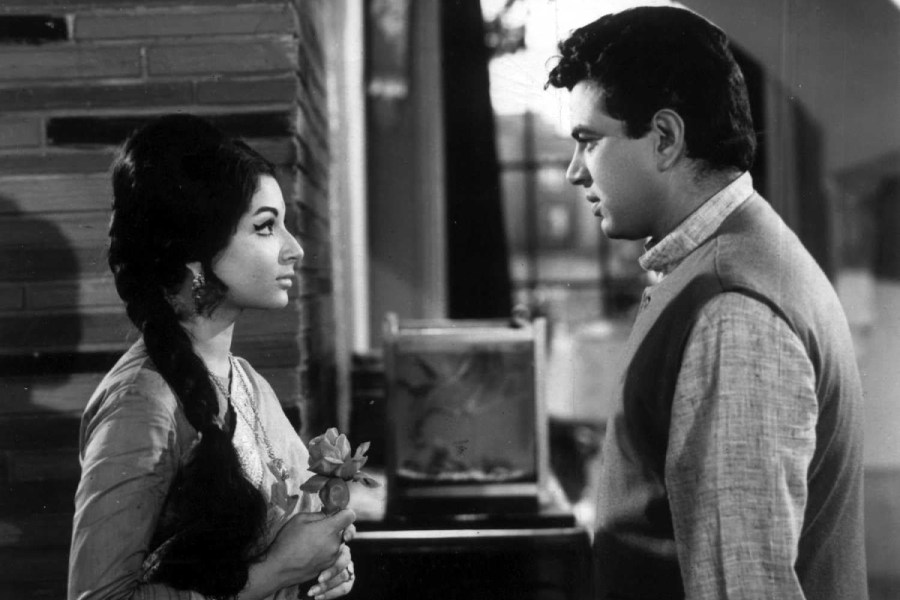
A still from 'Anupama' IMDb
Not all of Sharmila’s best songs were extroverted spectacles. In Hrishikesh Mukherjee’s Anupama (1966), she played a shy, emotionally repressed young woman, and her inner world found exquisite expression in Hemant Kumar’s haunting ‘Kuch dil ne kaha’, sung with rare poignancy by Lata Mangeshkar. In Safar (1970), the tragic undertones of her romance with Rajesh Khanna found voice in a soundtrack glittering with gems which were not mere interludes, they were deeply rooted in the film’s emotional journey.
Sharmila had a unique ability to let the camera linger – her stillness, her gaze, the way she emoted through micro-expressions allowed the music to resonate more deeply. She never overshadowed the song, nor was she overshadowed by it. There was perfect harmony between actor and music.
Hemant Kumar’s ‘Kuch dil ne kaha’ is a masterclass in restraint, both musically and emotionally. Kaifi Azmi’s introspective lyrics, sung with hushed intensity by Lata Mangeshkar, convey a deep well of unexpressed longing. The minimal orchestration, featuring delicate strings and flute, creates a tranquil soundscape that allows the melody and emotions to shine. The song floats like a sigh, matching the unspoken emotions of the character. In Anupama, silence is more eloquent than words, and this song captures that ethos perfectly. As the camera rests on her face, her expressions shift gently, revealing wistfulness, resignation and a flicker of hope. Sharmila’s poise and vulnerability make the character’s sadness palpable, giving the song its haunting edge. In a time when melodrama was often the norm, this performance, and this song, show how powerfully cinema can speak through silence and stillness.
The same goes for ‘Hum thay jinke sahare’ in Safar. Kalyanji-Anandji’s minimalist arrangement and Indeevar’s desolate lyrics make it one of Hindi cinema’s most heart-wrenching laments. It arrives at a moment of abandonment and emotional betrayal, conveying a love that withered in the shadow of fate. Sharmila brings depth and dignity to a character trapped between love and duty. In this sequence, her expressions register a profound sense of loss – not loud, but etched in the weary stillness of her face. Her eyes convey a storm of emotion – guilt, confusion, sorrow – and yet she maintains a stoic composure.
Before moving on to what would be her most fecund phase with Rajesh Khanna, Sharmila was part of another musical blockbuster that has more or less been forgotten: OP Ralhan’s Talash (1969). The soundtrack, composed by SD Burman, features a collection of melodious songs that capture a range of emotions. Notable among them are ‘Palkon ke peechhe se’, ‘Aaj toh junjli raat maa’, ‘Khayi he re humne’ and ‘Kitni akeli’, in each of which the star’s elegance and screen presence add charm to the musical sequences, complementing the poignant lyrics. If the music of the film is the star here, she is the light that makes it burn bright.
The Rajesh Khanna phase: A soundtrack to superstardom
Rajesh Khanna and Sharmila Tagore formed one of the most melodious screen pairs in Hindi cinema. Beginning with Aradhana (1969), their onscreen chemistry was as much musical as romantic. ‘Roop tera mastana’, ‘Kora kagaz tha’, ‘Chanda hai tu’ and ‘Mere sapno ki rani’ weren’t just chartbusters; they redefined how romance was picturised. ‘Roop tera mastana’ is particularly notable for being shot in a single take, a sensual, dimly-lit sequence that was ahead of its time. Sharmila’s poise in the sequence is a lesson in controlled seduction. It speaks of the patriarchal nature of our films’ narratives that though Sharmila was a vital part of each of these songs, the film and its songs are associated more with Rajesh Khanna.
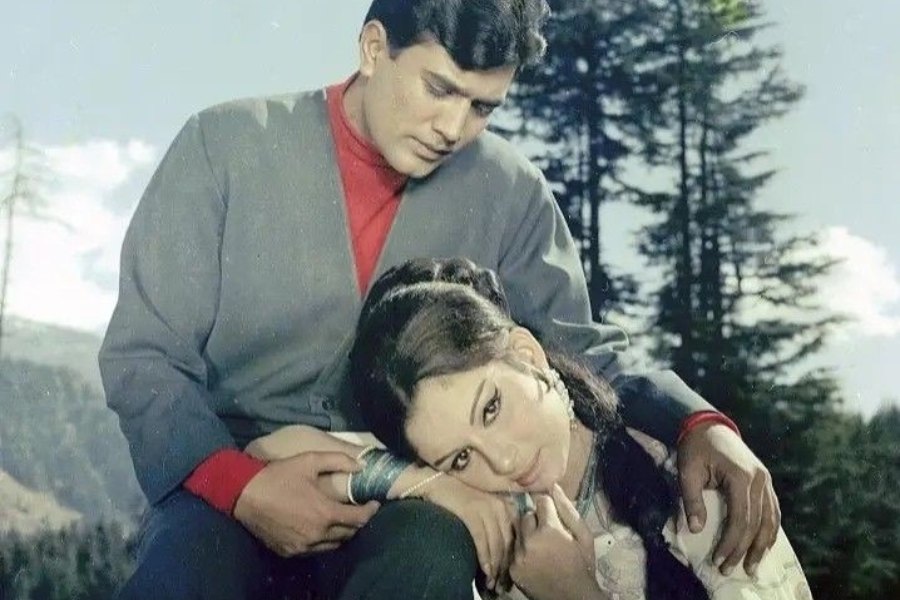
A still from 'Aradhana ' IMDb
This was followed by Amar Prem (1972), which perhaps features the most iconic songs of their partnership. ‘Chingari koi bhadke’, ‘Kuch to log kahenge’ and ‘Raina beeti jaye’ gave the film a poetic, almost classical mood. Sharmila’s role as a courtesan was elevated by the soul-stirring quality of these songs, which added layers of dignity, tragedy and grace to her performance.
The Rajesh Khanna partnership flowered with the celebrated songs of Yash Chopra’s Daag (1973), which features probably the most iconic and sensual love song in their repertoire: ‘Mere dil mein aaj kya hai’. Again, being sung by Kishore Kumar and shot on Rajesh Khanna, one tends to forget that Sahir’s lyrics actually address the woman (much like Safar’s ‘Jeevan se bhari’), and the star lends the song a rare dignity. Daag also had the haunting duet ‘Hum aur tum’ and the high-pitched lament ‘Jab bhi jee chahe’, both of which benefit immensely from what she brings to the screen as much as her male co-star. Among their other collaborations, there’s the vastly underrated Tyaag, which boasts some of the finest duets in Hindi cinema featuring Kishore Kumar with Lata Mangeshkar and Asha Bhosle. The film tanked and its music became a footnote to be discussed by fan groups.
Musical depth in mature roles: Mausam, Dooriyan and Griha Pravesh
In the 1970s, as Sharmila took on more complex roles, the music accompanying her became more introspective. Mausam (1975) is a standout, with Madan Mohan’s score featuring ‘Dil dhoondta hai’ (composed in two sublime versions, one a duet featuring Sharmila), which encapsulated the film’s themes of regret and lost love. Gulzar’s direction gave Sharmila ample space to explore dual roles – of the mother and her bitter, exploited daughter – and the music accentuated these emotional contrasts.
Lata Mangeshkar’s voice in ‘Ruke ruke se kadam’ carries the broken cadence of a soul stumbling through despair. Composed by Madan Mohan and penned by Gulzar, the song is an aching cry of a woman lost in the ruins of her past, her dreams withering with each hesitant step. The music is sparse, drawing attention to the aching pauses and faltering rhythm, mirroring the protagonist’s fragmented life. In this song, she walks the line between defiance and fragility. Her eyes are vacant, her movements listless, and yet there’s a trace of buried hurt that flickers now and then. Sharmila captures the disillusionment of a woman who has seen too much, suffered silently, and now moves through life like a ghost. The song, and her performance in it, became a searing statement on women scarred by social neglect. And it remains an unforgettable moment in her storied career.
Bhimsain’s Dooriyan (1979) features two fine melodies – ‘Zindagi mein jab tumhare’ and ‘Zindagi mere ghar aana’ – composed by Jaidev, both amply demonstrating Sharmila’s ability to convey the nuances of a situation through a song. Among the most neglected of Hindi film albums, Griha Pravesh (1979) dealt with marital intimacy, disillusionment and emotional fatigue. Kanu Roy’s – the composer had earlier given Sharmila one of her finest songs, ‘Naina hai pyase mere’, in Aavishkar – music created a soundscape of melancholy and introspection, often mirroring Sharmila’s internal turmoil. The album deserves an essay of its own. In both these films, Sharmila’s ability to become the music was crucial – she didn’t merely lip-sync but embodied the mood, often rendering the lyrics visible in her eyes and body language.
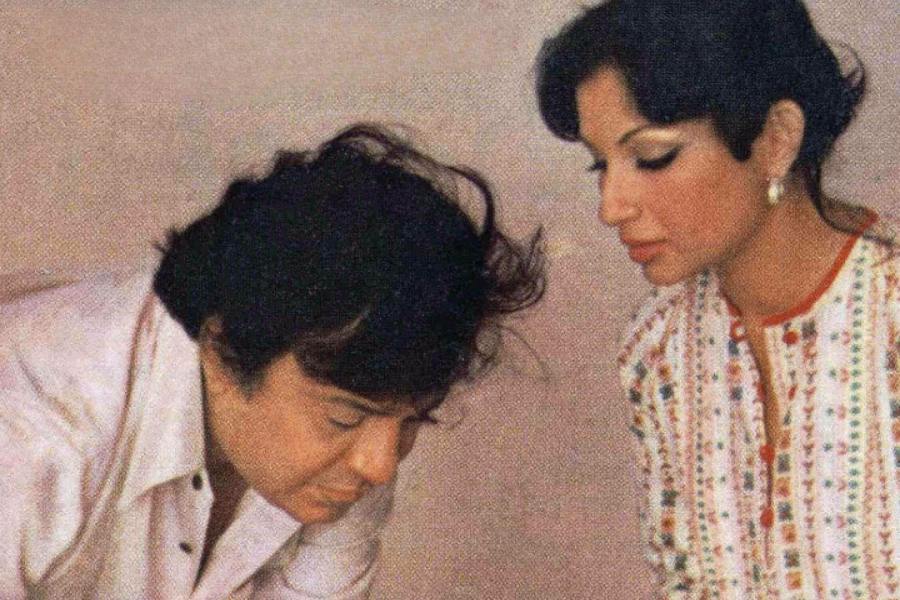
A still from 'Dooriyan' IMDb
The songs shot on Sharmila did more than just provide musical relief. They defined characters, accentuated transitions and elevated emotional subtext. Whether it was the grandeur of a Shammi Kapoor-starrer, the romantic milieu of a Rajesh Khanna film, the poetic realism of Gulzar, or the melancholic explorations of Hrishikesh Mukherjee, music followed Sharmila like a shadow, sometimes glittering, sometimes dimmed, but always graceful. She wasn’t just ‘featured’ in the songs; she interpreted them. That interpretive skill is what gives her songs an enduring appeal even today.
(Shantanu Ray Chaudhuri is a film and music buff, editor, publisher, film critic and writer)

